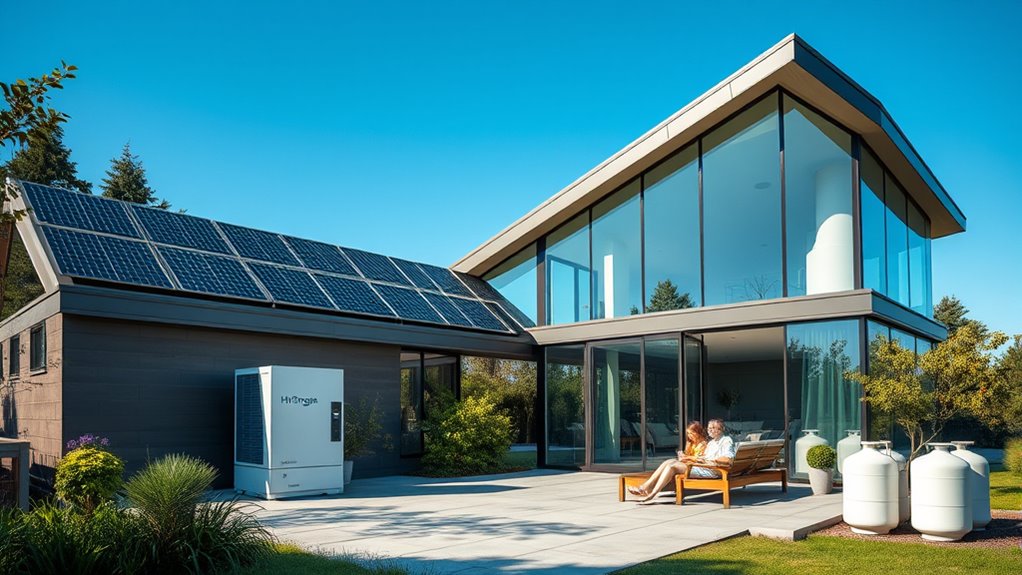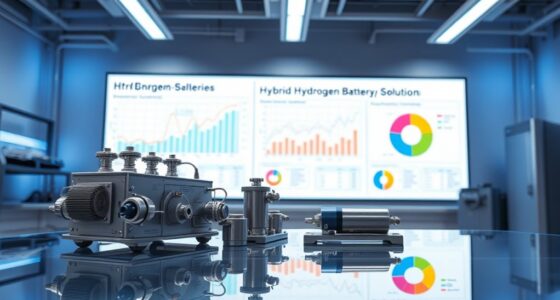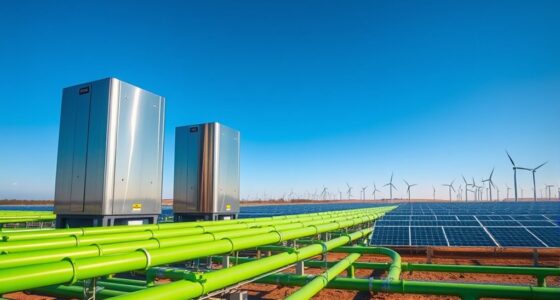Integrating hydrogen energy into your hybrid home helps you store excess solar or wind power, making your energy use more efficient and reliable. By installing safety measures like certified tanks and proper ventilation, you can safely handle and store hydrogen. Using fuel cells, you’ll convert stored hydrogen back into electricity when needed, boosting your energy independence. If you want to uncover more about how to safely and effectively make this switch, keep exploring the options available for your home.
Key Takeaways
- Install certified hydrogen storage systems and fuel cells to seamlessly convert stored hydrogen back into electricity.
- Incorporate smart controls to optimize hydrogen production, storage, and usage for energy efficiency.
- Ensure proper safety measures, including ventilation and avoiding ignition sources, during integration.
- Work with professional installers to comply with regulations and ensure system safety and reliability.
- Monitor hydrogen levels and system performance regularly to maximize renewable energy utilization and system responsiveness.

Have you considered how hydrogen energy could transform your home into a more sustainable and efficient space? Integrating hydrogen as part of your hybrid energy system offers exciting possibilities, especially when it comes to renewable storage. Unlike traditional batteries, hydrogen can store excess renewable energy generated by solar panels or wind turbines for long periods, ensuring you have a reliable power source during cloudy days or calm winds. This ability to store renewable energy efficiently means you can reduce dependence on the grid, lower your energy bills, and contribute to a cleaner environment.
Hydrogen offers long-term renewable storage, reducing grid dependence and lowering energy costs for a sustainable home.
However, safety remains a top concern when dealing with hydrogen. You need to understand and implement strict safety protocols to protect your home and loved ones. Hydrogen is highly flammable, so proper storage and handling are essential. Using certified containers designed for hydrogen storage, guaranteeing proper ventilation, and avoiding sparks or open flames are vital safety measures. Regular inspections and maintenance of storage tanks and pipelines help prevent leaks, which can be hazardous if unnoticed. Educating everyone in your household about these safety protocols strengthens your home’s resilience and minimizes risks.
Another aspect to contemplate is integrating hydrogen systems seamlessly with your existing renewable energy setup. For example, you might install a fuel cell that converts stored hydrogen back into electricity, providing a clean and efficient power source during peak usage times or grid outages. This setup maximizes your renewable storage capabilities and enhances your home’s energy independence. The process involves careful planning, including choosing appropriate storage options, safety measures, and integrating control systems that monitor hydrogen levels and system performance. Working with professional installers ensures that all safety protocols are followed and that your hybrid system operates smoothly and safely.
Incorporating hydrogen energy also opens up new opportunities for energy management. Smart controls can optimize when to produce, store, and use hydrogen, making your home more energy-efficient. This level of control helps prevent waste and ensures that your renewable resources are utilized to their fullest potential. As you explore hydrogen’s role in your hybrid home, keep in mind that advancements continue to improve safety and efficiency. Staying informed about the latest safety protocols and storage technologies will help you make the most of this innovative energy source. Additionally, understanding the regulations and standards for hydrogen storage and safety can further ensure your system’s compliance and security.
Frequently Asked Questions
What Is the Initial Cost of Installing Hydrogen Systems?
The initial cost of installing hydrogen systems varies, but a detailed cost analysis shows it typically ranges from $10,000 to $30,000 or more. During the installation process, you’ll need to factor in equipment, safety measures, and integration with existing systems. Factors like system size, location, and technology type influence expenses. While the upfront investment can be significant, the long-term energy savings and environmental benefits often justify the initial costs.
How Safe Is Hydrogen Energy for Residential Use?
Hydrogen energy is considered safe for residential use, with rigorous safety protocols in place. Notably, hydrogen leaks are less dangerous than natural gas because hydrogen disperses quickly and is less likely to accumulate. Proper hydrogen storage and adherence to safety protocols, like leak detection and ventilation, ensure safety. When managed correctly, hydrogen systems pose minimal risk, making them a reliable, eco-friendly energy source for your home.
What Maintenance Do Hydrogen Energy Systems Require?
Hydrogen energy systems require regular maintenance procedures to guarantee system durability and safety. You should check for leaks, inspect storage tanks, and monitor system components frequently. Keep an eye on pressure levels and ensure valves function correctly. Scheduling professional inspections annually helps maintain peak performance. Proper upkeep minimizes risks and extends your system’s lifespan, providing reliable, clean energy for your home. Staying proactive with maintenance keeps your hydrogen system safe and efficient.
Are There Government Incentives for Hydrogen-Powered Homes?
You’ll find that government incentives for hydrogen-powered homes are growing, thanks to policies promoting clean energy. These policy incentives can include tax credits, rebates, and grants, making it more affordable for you to adopt hydrogen energy. However, safety regulations are strict to guarantee your safety and that of your community. Stay informed about local policies, as incentives vary by region, and always prioritize safety when integrating hydrogen systems into your home.
How Long Does It Take to Implement Hydrogen Integration?
It typically takes several months to implement hydrogen integration in your home. First, you’ll need to install proper hydrogen storage and energy storage solutions, which can take a few weeks. Then, the system setup and safety checks might add another few weeks. Overall, plan for around three to six months, depending on your home’s complexity and local regulations, to facilitate a smooth and safe shift to hydrogen energy.
Conclusion
As you consider integrating hydrogen energy into your hybrid home, the possibilities are exciting yet uncertain. Will this clean, versatile power source become the standard or remain a niche innovation? The future holds surprises, and staying ahead means understanding these emerging technologies now. Don’t wait too long—what’s next could redefine how you live sustainably. Are you ready to be part of this energy revolution, or will you miss out on the next big leap forward?








